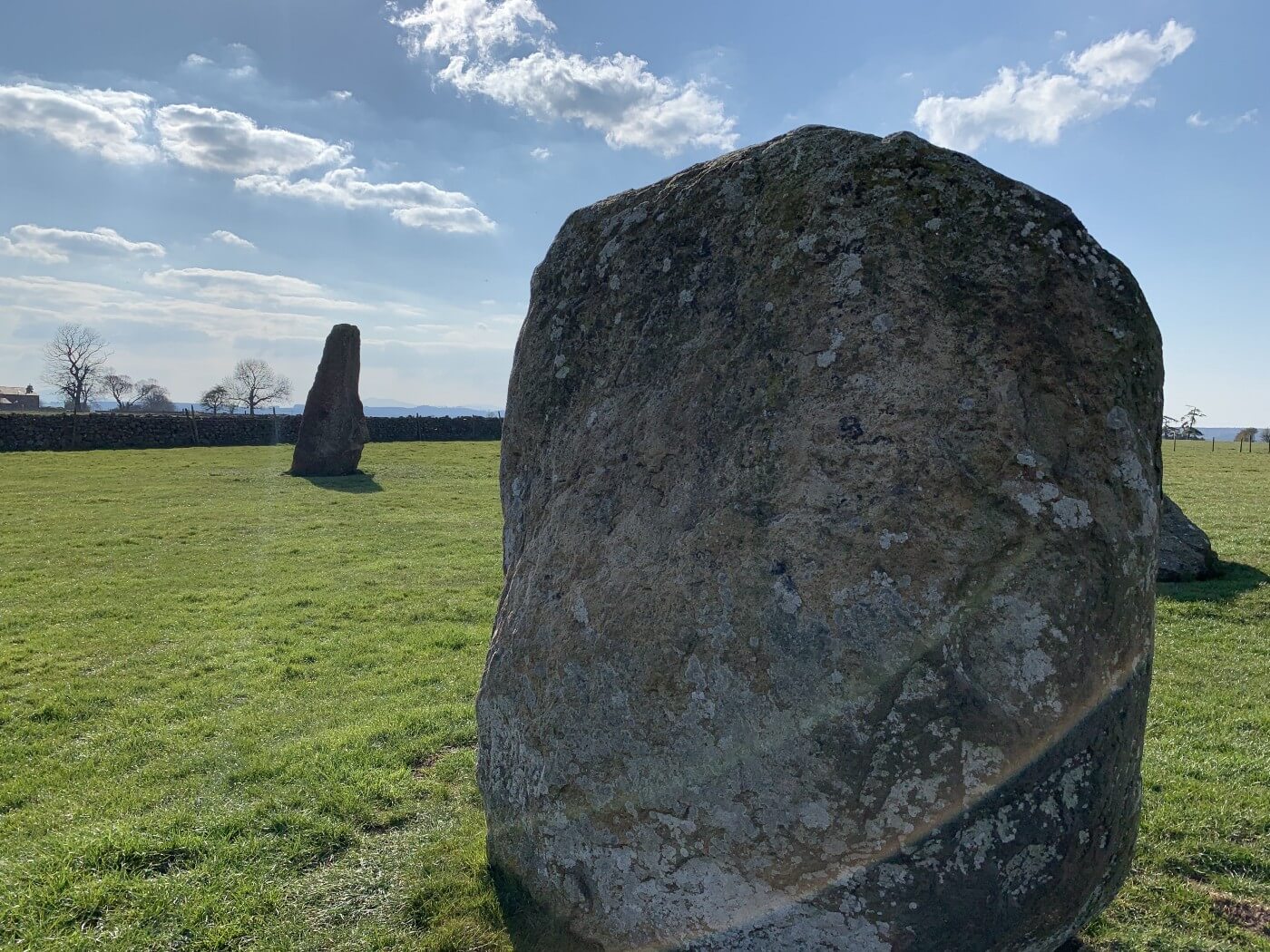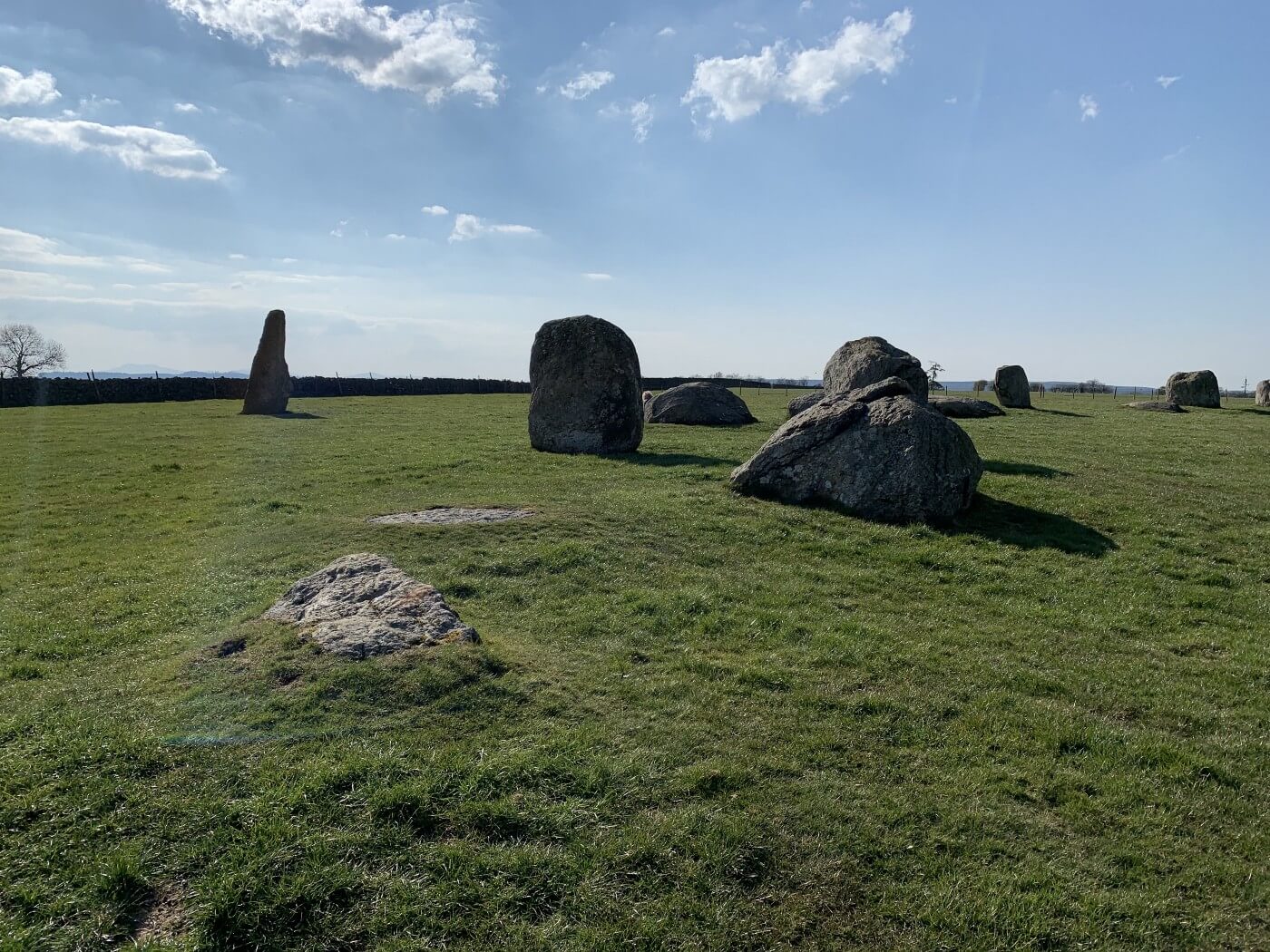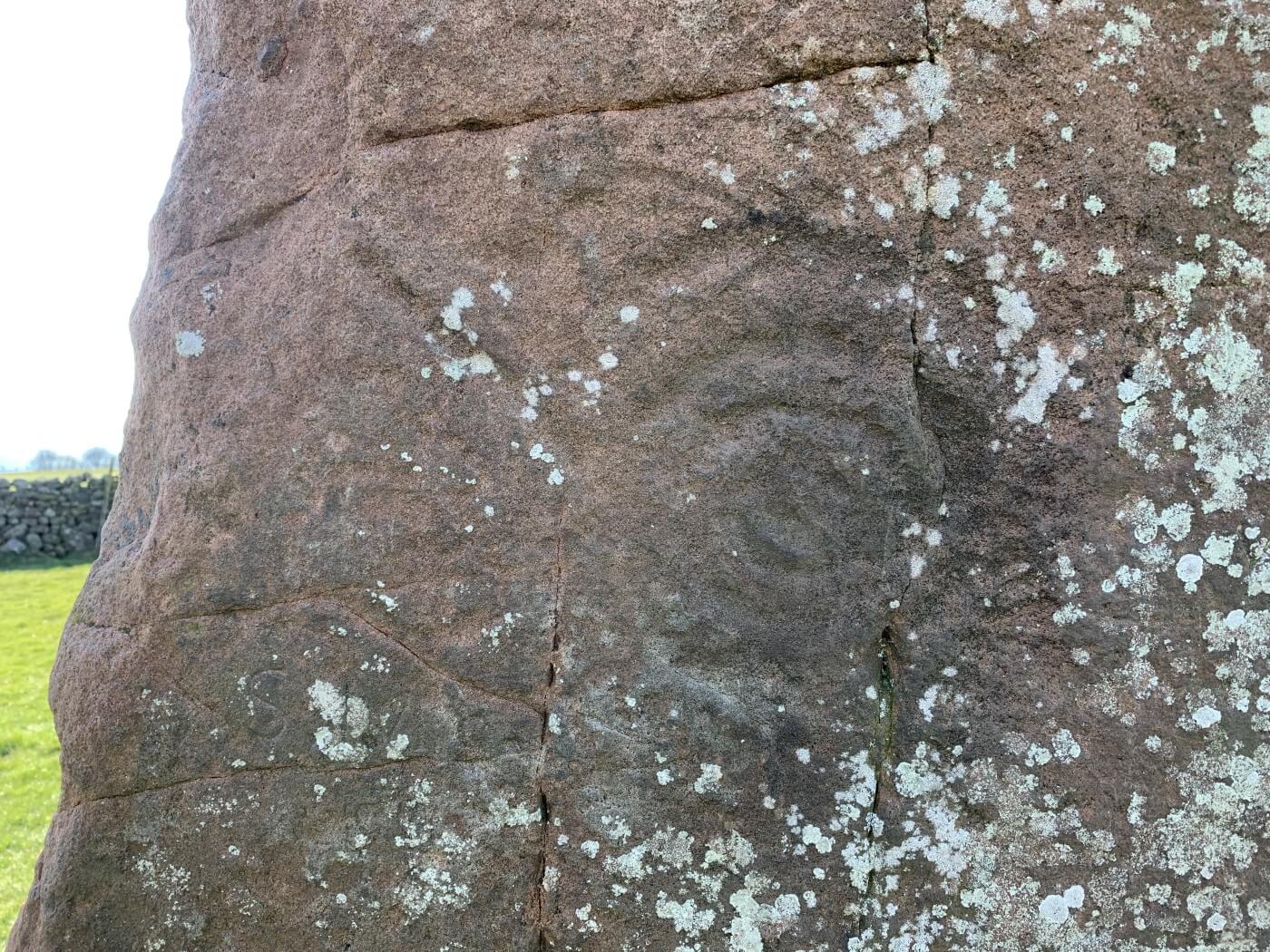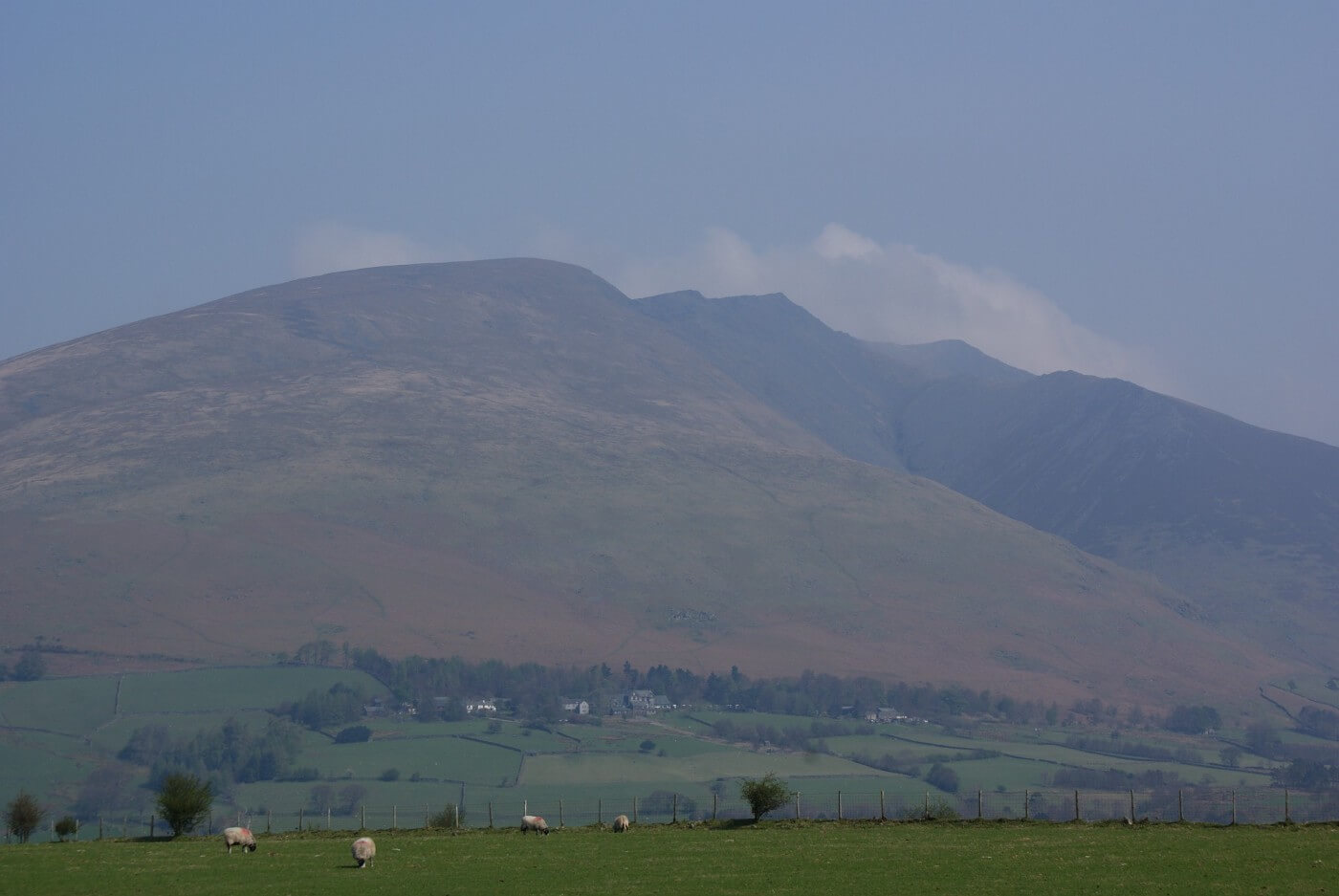Long Meg Stone Circle

Long Meg And Her Daughter by Tony Walker
Long Meg And Her Daughters
Long Meg and her daughters is a large stone circle that lies some miles outside Penrith in Cumbria near the village of Little Salkeld. It’s the sixth-largest stone circle in North-West Europe. It has never been formally excavated but what we see today probably dates from the late Stone Age and the early Bronze Age.
Long Meg sits close to the River Eden. There are many neolithic monuments nearby in the Eden Valley, and it seems to have been a cultural focus for Neolithic people.
The most impressive monuments like Long Meg, King Arthur’s Round Table at Eamont Bridge and Mayburgh Henge are very close to the River Eden, which is undoubtedly significant. There may have been a ritual approach to the river from each of them. Here at Long Meg, on the river’s edge, there is a cursus nearby.
A cursus is a racing track shape layout of an unknown purpose. There is one close by Stonehenge too.
Though Long Meg is impressive today, there was more to her and her family in earlier years.
The Circle
There are fifty-nine stones left, of which only twenty-seven stand upright. It is said that it is impossible to count them and come to the same number every time. But to be fair, they say that about lots of stone circles, perhaps most famously about the Rollright Stones in Oxfordshire.
There may have been as many as seventy stones at one time. There were attempts to blast them down at different times, but thankfully Long Meg now is a scheduled ancient monument.
Little Meg is the name given another circle nearby, cleared for agriculture, and the stones dumped at the side of the field, but Long Meg has never been cleared. Little Meg is much smaller and far less impressive than Long Meg and Her Daughters, but Little Meg has less weathered cup and ring marks and is worth a visit if you’re in the area.
In his account from 1599, the historian Camden describes over two hundred stones with two tumuli in the centre at Long Meg.
Aerial photography in 1988 revealed a substantial earth enclosure to the north of the circle, which meets and matches the flattened northern segment of the ring.
This may relate to the report of William Stukely, who visited in the Seventeenth Century. At that time, he noted another circle, where the current farmhouse is to the north, there is a circular ditch that must predate Long Meg & Her Daughters because they have been set up in a way that accommodates the ditch.
When Sir William Dugdale visited Long Meg in the 17th century, he saw two burial barrows made of local cobbles.
I read an interesting theory in Brian Syke’s book The Blood of The Isles (page 143) that the burial mounds like these may have been developed from shell burials in Southern Spain. As the hunter-gatherers came north along the Atlantic coasts of Europe, the shells were replaced by stones or earth, leading to the development of Long Barrow type mounds.
These mounds seen at Long Meg in the 17th century were not long barrows, I am merely referencing and comparing what was possibly seen to the practice of heaping stones in long mounds over the dead of the tribe.
There is a gypsum mine nearby, and gypsum is mined all down the Eden Valley. Therefore, there has been a suggestion that the original ditched enclosure for the circle was whitewashed with the gypsum to make it shine.

Long Meg on A Sunny Day by Tony Walker
Long Meg Herself
Long Meg herself broods outside the circle, pointing in. She stands twelve feet high and is adorned with cup and ring marks, similar to those found on other stone circles erected by this culture across northwest Europe.
One theory is that these designs are shamanic in origin. The shamans of many cultures journey to the otherworld in an ecstatic state, and in this state of altered consciousness, they reportedly see vortices like these cup and ring carvings.
The face of Long Meg is the side that has the marks, and this side looks towards the centre of the circle. In the middle of this face, a cup is carved in the middle with three rings and a spiral.
At the bottom of the stone are three faint figures with another spiral and another cup and ring mark.
At the top part are very faint rings, ovals and spirals. They have weathered over the past three thousand years.
Some of the other stones have carvings but none so clear as those on Long Meg.
Long Meg weighs about nine tons. She is made from local red sandstone, while the other stones are of rhyolite or odd rocks brought here by the glaciers. Four of them are made of quartz stone, and their placement in the ring may mark certain calendar events.
Aubrey Burl (1926–2020) was an archaeologist specialising in megalithic monuments. He believed that Long Meg was raised at a separate time to the current circle.
Long Meg has some cup and ring marks carved into her — almost obliterated by time. Cup and Ring marks are found on these kinds of monuments in Britain and Ireland. One theory is that they are shamanic in origin. The shamans of many cultures journey to the otherworld in an ecstatic state, and in this state of altered consciousness, they reportedly see vortices like these cup and ring carvings.
Long Meg stands at the entrance to the circle and marks the point where the sun rises on the Midwinter Solstice.

Spiral Rock Art on Long Meg by Tony Walker
Legends
There are various legends about how Long Meg came to be.
One story is that the stones were once a coven of witches who were turned to stone by a wizard from Scotland named Michael Scot.
Michael Scot gets a lot of bad press. He was, in fact, a very learned man who went to Italy as a scholar and lived there most of his life, returning later to the borderlands between England and Scotland, where he was said to have worked wizardry. He had an evil book that was so magic that after his death, the monks of Holme Cultram abbey hung it on an iron spike in their library at Wolsty Castle and no one would dare touch it.
Another version is that Long Meg and her Daughters were turned to stone for dancing on a Sunday.
Yet another is that the outer stones were men trying to enchant Meg so that she would give herself to them. As a punishment for their sinful plans, everyone, including poor Meg, was turned to stone.
Another legend states that if you walk round the circle and count the number of stones correctly, then put your ear to Long Meg, you will hear her whisper.
It is also told that if anyone shatters Long Meg, they will find her full of blood.
Another story says that Long Meg was a witch, ‘Meg of Meldon,’ who was alive in the early 17th century. However, Meg of Meldon was from Morpeth, which is seventy miles away on the far side of the country over the Pennines and is our Long Meg is unlikely to be that Long Meg.
But our Long Meg is much older than Henry VIII. She and her Daughters belong to the late Stone Age or early Bronze Age.
In his book The Modern Antiquarian, Julian Cope says that Long Meg was a mythical figure buried south of Westminster Abbey in London in Pagan times.
However, Meg is a pet name for Margaret, a widespread woman’s name throughout most of English history, and Long means tall. Compare the Medieval Scottish cannon known as ‘Mons Meg’. It seems that the female name ‘Meg’ was affectionately tagged onto objects in the old days.
Anything tall and thin, like this standing stone, got the name Long Meg. But our Long Meg is much older than Henry VIII. She and her Daughters belong to the late Stone Age or early Bronze Age.
You will notice that the road to the farm cuts through the circle of stones. The stones themselves are impressively large and roughly formed. One tall stone stands to the North West — Long Meg herself.
There is also a story that a Colonel Lacy, who excavated the nearby Lacy’s Caves on the banks of the Eden, tried to demolish the circle by blasting. As his men set the charges, a strange storm arose, and rain fell, and thunder rumbled. Lightning snaked across the sky, and the workmen, soaked to the skin, looked up in awe. They believed that some force was trying to stop them from interfering with Long Meg. They fled and refused ever to bother Long Meg again. So Long Meg and Her Daughters still stand.
Modern Tales About Long Meg Stone Circle
Long Meg is still a place full of energy. In the early 1990s, a local girl called Paula Thompson and her friends decided to do a bit of ghost hunting at Long Meg. Friends had gone there in their cars late at night to sit and talk and do what teenagers do. They reported seeing flashes of light outside the vehicle coming from the stones. They told Paula, and they all decided to go back another night as a group.
It was late — after midnight — and at first, Paula wouldn’t get out of her car. Her friends teased her, and so, reluctantly, she opened the door. By that time, the others had spread out around the circle. There was some light from the moon, and so she walked over to Long Meg, the tallest stone. She saw a dark shape in front of her. As she got closer, it started to move towards her very quickly. She thought it was a male friend having a laugh and called out jokingly for him to stop. He didn’t stop, and she saw that he was going to run into her. As it got closer, she saw the shape wasn’t her friend. To her horror, it ran right through her. She says she felt cold and frightened and rushed back to the car.
Another time a group of people went there late, they met a coven of witches. You will often see offerings of flowers around Long Meg herself or hanging in the tree nearby when you visit Long Meg.
There were pigeon feathers, flowers, coins, an acorn, and an egg when we were there.
Blencathra

Blencathra from Castlerigg Stone Circle by Tony Walker
Visible from Long Meg is the mountain called Blencathra or Saddleback. The earlier name Blencathra is Cumbric equivalent to the Welsh Blaen Cadeir, Chair Front or Top, and when you look at the shape of the mountain, you can see why it was thus called.
The Pennine hills are to the east, with the highest point being Cross Fell, which was once the Devil’s abode.
Looking south, you see the Howgill Fells with the high points of The Calf. Long Meg is well situated as a viewing point for all these high points.
Conclusion
Long Meg is well worth a visit if you are in the area. Why not arrange a stone circle tour of Cumbria if you are there. It may take you a few days, but the landscape is spectacular.
